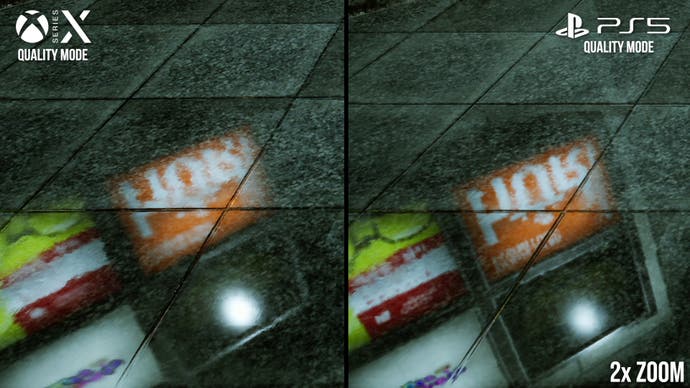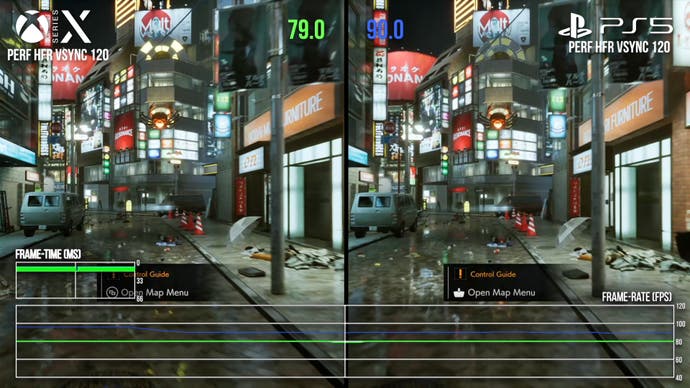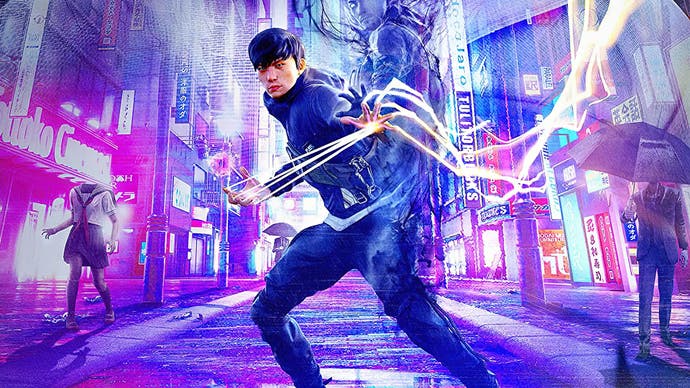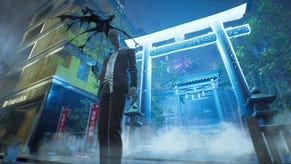Ghostwire: Tokyo on Xbox retains the PS5 version's problems - and adds a bunch more
After a year's wait, the Series X and S ports are disappointing.
After a year of PlayStation 5 exclusivity, Ghostwire: Tokyo is finally out on Xbox. This open-world horror-first-person-adventure mashup is definitely a unique game, but it did suffer from a range of technical issues when it first launched. Poor performance and sluggish controls plagued the PS5 version of Ghostwire, along with an overwhelming range of graphical options. The good news is that the game looks just as good on Series X, but the bad news is that none of the technical issues have been addressed on PS5 since launch - and so the Xbox versions are similarly affected. Even more disappointing is that performance is lower on Series X, while there are noticeable reductions in quality to the game's striking ray-traced effects.
Ghostwire: Tokyo ships with a sobering variety of visual modes - far too many, really, with none of them providing a definitive experience. On PS5 and Series X, there are an effective 10 visual options for players to choose from - quality, performance, and then multiple variants of high frame-rate quality and high frame rate performance, depending on the refresh rate of the console and whether you want to engage v-sync or not. And on top of that, there are five different settings for motion blur quality - the default looked fine, so we stuck with it. The situation is much simpler on Series S, with a just one quality and one performance mode - but no ray tracing effects.
Ghostwire: Tokyo is an Unreal Engine 4 based game with basic visual features that don't change too much between these options, though performance and quality modes on Series X differ in one key respect - ray tracing. The quality modes pack RT reflections and hybrid RT shadows, and they do make a pretty big impact on the visuals. Tokyo in Ghostwire is perpetually rain-slicked, which means a very heavy use of reflections across the environment. The mix of cubemaps and SSR that's used in the performance mode does a reasonable enough job, but it looks pretty lacklustre when the screen-space information it needs is occluded.
The RT reflections obviously don't suffer from this issue, and look reasonably sharp and very consistent no matter what angle you view them from. The lighting in the BVH structure does seem quite simplified here, so the RT tends to look a bit too dark, but outside of that it does look very attractive and adds quite a lot to the visuals here I'd say. Both the 'quality' and 'high frame-rate quality' modes pack these effects with good results on both. The resolution of the reflections seems slightly lower in the high frame-rate quality variant, but it's a minor difference that's only really noticeable in head-to-heads.
Unfortunately, when we bring in the PS5 release it's evident that the Series X is getting a somewhat compromised experience. The RT effects are somewhat higher-resolution on the Sony platform and there are some small cutbacks on Series X that look a little odd. It's not a huge difference, but the RT is subtly degraded on the Xbox. RT shadows are on show here as well, though it's not as much of a stand-out.
Basically, the quality modes on Series X get pin-sharp, stencil-like shadows on certain bits of interior detail. It's a nice effect, but the slightly diffuse look of the shadow maps can look a bit more realistic depending on scene lighting. Plus, in a couple of areas, the RT shadows on Series X actually seemed misaligned, with light cast through walls and coming out at awkward angles. This was true across the high frame-rate and regular quality modes, which seem to have near-identical RT shadows. However, if we bring the PS5 version back into the picture, the same misalignment issues are totally fixed. It's a bizarre and slightly odd state of affairs, but the RT shadows do look substantially better on PS5 when these alignment issues surface.
| Mode | PlayStation 5 | Xbox Series X | Xbox Series S |
|---|---|---|---|
| Quality | 1620p | 1512p | 1296p |
| Performance | 1296p | 1296p | 900p |
| HFR Quality* | 1080p | 1080p | - |
| HFR Performance* | 1080p | 1080p | - |
* Counted with v-sync enabled at 60Hz output, all figures approximate. No RT in Xbox Series S quality mode. Non-v-sync alternative modes also available.
Ghostwire: Tokyo has reasonably good image quality across all console platforms. The game appears to be using Unreal's TAA alongside AMD's FSR 1 to upscale from sub-4K base resolutions, and the results have a bit of a soft look but don't suffer much from aliasing or other image artifacts. Basically, as we scale up from the highest-performance options to the highest quality options, there's a corresponding increase in image detail on Series X. From a distance, the modes look similar enough but a closer view reveals missing detail and additional image breakup on the various performance modes.
The same is true on Series S. Again, both of the options here don't have ray tracing, but the quality mode does have extra image detail that is missing on the performance mode. FSR does keep them looking pretty close in stills, though the extra image breakup in gameplay at lower resolutions is noticeable. When we compare the Series X and PS5, the results are mostly quite similar, with a near-identical resolve across most modes. But there is one exception. The quality mode on PS5 looks slightly sharper and more coherent, in addition to its ray tracing advantages.
Pixel counts reveal that there is a resolution deficit for Series X in the quality mode in particular, although it's hard to nail down exact counts here as the FSR can muddy pixel edges, and there may be some subtle DRS as well. Broadly speaking though, the numbers for both consoles are similar. As you might expect, Series S takes a hit on these topline figures, though it's still a pretty respectable turnout for the junior machine. The FSR means that both modes look sharp enough, but the additional image breakup in the performance mode is noticeable.

Unfortunately, performance is where things really break down for Ghostwire: Tokyo, across all console platforms. The game just doesn't run well at all, and if anything the new Xbox versions actually perform worse than the existing PS5 release. Let's start with Series X. The worst-performing option here is the game's quality mode. 30fps is the target here and it's reached quite consistently - but it's plagued by improper frame-pacing, providing a jerky, inconsistent motion that in practice feels like the game is running at a lower update.
Thankfully that's the only mode that's locked at 30. The performance mode, for instance, clocks in with a 60fps target. Unfortunately, in practice it's typically a 50-60fps affair, with a near-constant barrage of dropped frames during open-world gameplay. Ray tracing is dropped here and the resolution is cut-back, but that still isn't enough to reach anything like a stable 60fps. The next step up is the quality mode with high frame-rate and v-sync at 60Hz output. This is probably one of the more desirable options, as we get higher frame-rates alongside good ray tracing. Unfortunately, it too comes saddled with sub-standard performance, hovering around 45-60fps in typical play.
As we reach the higher tiers of the performance ladder, the game continues to operate in an awkward area. Toggling the Performance HFR option with v-sync at 60Hz on still can't get us a locked 60fps. Ghostwire usually operates at about 55-60fps here but is dropping frames on a very frequent basis.

Toggling 120Hz on at the system level does allow Ghostwire to hit higher frame-rates but these options operate with wobbly, unlocked performance. Quality HFR with v-sync at 120Hz still bottoms out in the 40s, but can occasionally hit 60fps in more limited circumstances. Likewise for the Performance mode HFR with v-ysnc at 120Hz, which mostly operates in the 60-80fps range but can dip lower if pushed. Curiously, both of these options showcase a pretty unstable frame-time readout, indicating that the game may be CPU limited. Even though overall performance may be respectable in the HFR performance mode, for instance, those short frame-time spikes are pushing certain frames above 16 milliseconds which is what causes the issues when set to 60Hz output.
When we bring in the PS5 version of the game, the results are a little disheartening. The HFR performance mode operates with a considerable advantage - about 10fps or so - over matched gameplay. The 60Hz mode options do generally stick to 60fps across both consoles in this sequence, but PS5 doesn't suffer any dips, while Series X has periodic stumbles even with little of note on-screen. It's a curious problem, and may be driven by CPU-related issues. In general gameplay, PS5 manages to hold closer to 60fps than Series X, though the differences aren't massive. It's just disappointing to see that there are still the same issues a year on from launch - and the situation has actually got worse for Xbox users.
Series S runs considerably worse than either of the higher-end console platforms. Quality mode targets 30fps here, again without any ray tracing enhancements, but the console suffers from debilitating frame-pacing problems. These actually seem much more pronounced than on Series X, perhaps a sign that the game internally is running with frame-times that are right on the 30fps margin. The performance option tries to hit 60fps, but in practice it can bottom out in the low 40s. This is a very disappointing result, especially considering that the Series S doesn't have additional higher-performance options available.

PS5 and Series X also pack four extra modes with no v-sync that suffer from constant, intrusive screen tearing all over the image. These are really best ignored in my opinion, as the tearing looks horrible, even if the input response is a bit better as a tradeoff. Of all the mode options, these really shouldn't have been included for console players. For those with higher-end displays, activating VRR would typically help with the game's more unstable graphical modes, but there are some caveats here. With the quality mode with v-sync enabled, I can still spot some noticeable stutters. It's definitely a good improvement from the regularly-refreshed option, but it's not perfect. Perhaps we're seeing some CPU-driven frame-time spikes from time to time here that VRR wouldn't be able to smooth out. This is the same on PS5 as well.
Also baffling is that the non-v-synced modes operate with heavy screen-tearing on Series X so they don't seem to be working with VRR properly. This isn't an issue on PS5, but it does crop up on Xbox with these modes. Again, it's hard to understand why these options are in the game at all, but at least on PS5 they run OK with VRR.
Finally, Ghostwire: Tokyo's input issues are still a big problem on Series X. Camera movement still feels laggy, with awkward-seeming acceleration. Higher frame-rates seem to fix this problem to some degree, so I'd recommend sticking to the better performing modes if you want more satisfying input response. This was an issue on PS5, and seems basically unresolved on the Series consoles.
Ghostwire: Tokyo on Xbox Series S and X is a big disappointment. The key problems from the PS5 release haven't been fixed so performance is inconsistent, input feels very sluggish, and ideally the baffling range of visual options should be pared back to something manageable where the developers have delivered smooth, consistent optimised performance. Xbox has all the baseline issues but on top of that, frame-rates tend to be substantially lower and ray tracing quality is worse and suffers from visual glitches.
I'd love to see Tango Gameworks go back to the game and comprehensively address and improve the experience for all platforms, but a year out from the original release, meaningful fixes seem unlikely. It's especially curious considering Tango's other recent title - the superb Hi-Fi Rush - is the polar opposite of this game with a solid 60fps lock, pitch-perfect input, and only one well-calibrated visual option for console players. The basic configuration of the two games couldn't be more different, despite being made by the same development studio.
Ghostwire: Tokyo on Xbox needs additional work to bring it up to par with the PS5 release - but even that's not enough. A range of extra fixes are required to make this game everything it should be.










